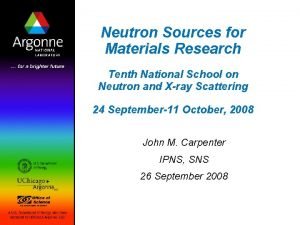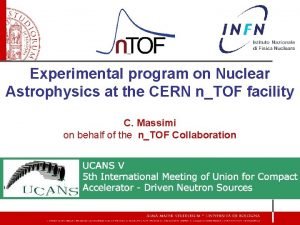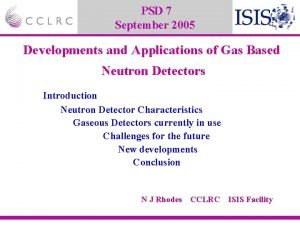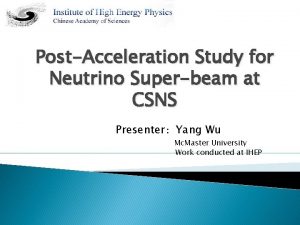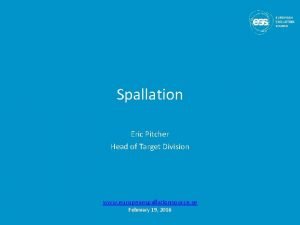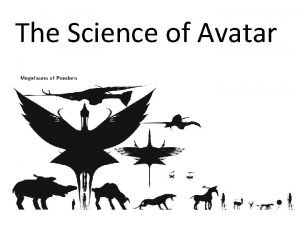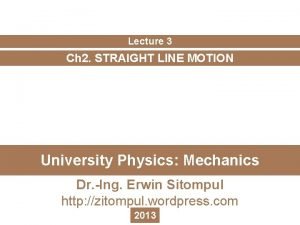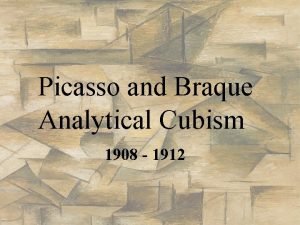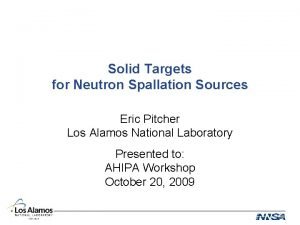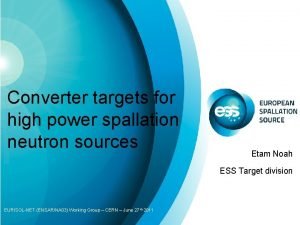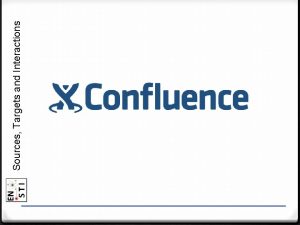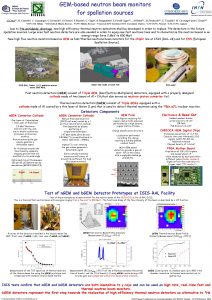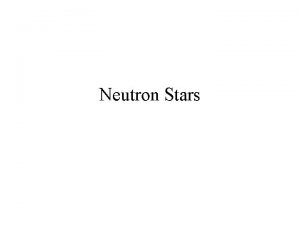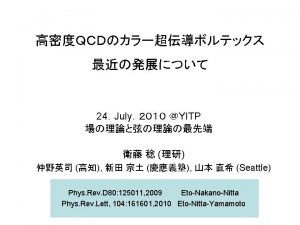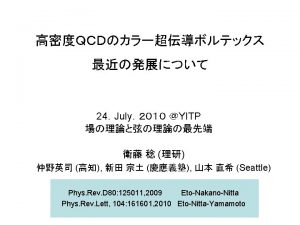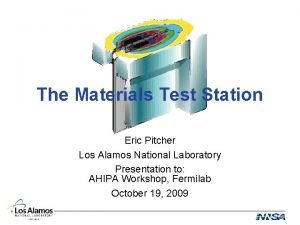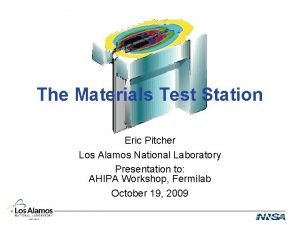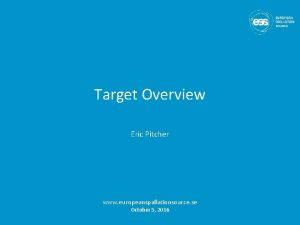Solid Targets for Neutron Spallation Sources Eric Pitcher













- Slides: 13

Solid Targets for Neutron Spallation Sources Eric Pitcher Los Alamos National Laboratory Presented to: AHIPA Workshop October 20, 2009

Solid spallation targets produce higher neutron fluxes than liquid metal targets • Neutron flux ~ neutron production density • Neutron production density ~ mass density • Mass densities (g/cc): – Tungsten: 19. 3 – Liquid Hg: 13. 6 – Liquid Pb-Bi: 10. 5 • So long as solid target coolant volume fraction in a tungsten target is less than 30%, solid tungsten targets will generate equal or greater neutron flux than liquid metal targets AHIPA Workshop, Fermilab, October 20, 2009 2

A tungsten target with heat flux up to 600 W/cm 2 can be cooled by water • For single-phase D 2 O: – 10 m/s bulk velocity in 1 mm gap – 70 m. A/cm 2 beam current density on 4. 4 -mm-thick W plate produces 600 W/cm 2 at each cooled face – A 1 -mm gap cooling each 4. 4 -mm tungsten plate gives a coolant volume fraction of 19% and an average mass density of 15. 9 g/cc – Neutron production density of this high-power target is – 15. 9 / 13. 6 = 17% greater than Hg – 15. 9 / 10. 5 = 51% greater than Pb-Bi AHIPA Workshop, Fermilab, October 20, 2009 3

An experiment was conducted to validate the target thermal-hydraulic performance Copper Test Section Surface Heat Flux Peak ~600 W/cm 2 1 mm x 18 mm Flow Channel Flow Rate 10 m/s Test Goals: • Determine single-phase HTC • Identify plate surface temperature @ 600 W/cm 2 • Measure subcooled flow boiling pressure drop • Investigate effect of plate surface roughness Cartridge Heaters Cartridge heaters in tapered copper block will simulate beam spot heat flux AHIPA Workshop, Fermilab, October 20, 2009 4

Thermal-hydraulic experiments using water coolant confirm heat-transfer correlations AHIPA Workshop, Fermilab, October 20, 2009 5

Experimental results match test data using Handbook heat transfer coefficient Thermocouple Locations Water flow Temperature (°C) AHIPA Workshop, Fermilab, October 20, 2009 6

For both liquid & solid targets, the target lifetime is limited by damage to the target front face • Experience base: ISIS (SS 316 front face): 3. 2 1021 p/cm 2 = 10 dpa SINQ (Pb-filled SS 316 tubes): 6. 8 1021 p/cm 2 = 22 dpa MEGAPIE (T 91 LBE container): 1. 9 1021 p/cm 2 = 6. 8 dpa LANSCE A 6 degrader (Inconel 718): 12 dpa SNS first target container (SS 316 L): 7. 5 dpa • MTS design, annual dose (70 m. A/cm 2 for 4400 hours): (T 91 -clad tantalum front face): 6. 9 1021 p/cm 2 = 23 dpa AHIPA Workshop, Fermilab, October 20, 2009 7

Rotating solid targets: What goes around comes around • Rotating target distributes: German SNQ Project rotating target prototype (circa 1985) – radiation damage to the target front face over larger area longer service life – Energy deposition over a larger volume, which reduces coolant volume fraction higher n prod density – Decay heat over a larger volume possibility to passively cool under design basis accidents AHIPA Workshop, Fermilab, October 20, 2009 8

Environment and safety issues: solid vs. liquid • Decay heat ~ beam power • Liquid metal targets distribute the decay heat within the total liquid metal volume, typically ~100 x larger than solid target volume liquid metal targets have ~2 orders of magnitude lower decay heat than solid (stationary) targets • Over the life of the facility, the waste volume is roughly the same for all targets, liquid metal and solid (both stationary and rotating) • For most countries, the disposal of activated Hg is more challenging than W or Pb AHIPA Workshop, Fermilab, October 20, 2009 9

Towards higher beam power: Which is better—more energy or more current? • Above ~800 Me. V, target peak power density increases with beam energy • Addressed by: – Higher coolant volume fraction for solid targets – Higher flow rate for liquid metal targets – Bigger beam spot AHIPA Workshop, Fermilab, October 20, 2009 10

Towards higher beam power: Which is better—more energy or more current? • If target lifetime and coolant volume fraction is preserved, higher beam current requires larger beam spot 1. 8 3. 6 1 MW MW MTS Beam Footprint on Target AHIPA Workshop, Fermilab, October 20, 2009 11

Peak neutron flux goes as Pbeam 0. 8 Φpk ~ Ebeam 0. 8 ibeam 0. 8 Ebeam = 0. 8 Ge. V ibeam = 1 m. A Φpk ~ ibeam 0. 8 AHIPA Workshop, Fermilab, October 20, 2009 Φpk ~ Ebeam 0. 8 12

Summary • A water- or metal-cooled stationary solid target is viable beyond 1 MW – Solid targets have higher neutron production density than liquid metal targets – Replacement frequency is determined by target front face radiation damage, and is therefore the same as for a liquid metal target container if the beam current density is the same – A rotating solid target will have much longer lifetime than stationary targets • Target “performance” ~ (beam power)0. 8 – Does not depend strongly on whether the power increase comes from higher current or higher energy AHIPA Workshop, Fermilab, October 20, 2009 13
 Neutron fission
Neutron fission Cristian massimi unibo
Cristian massimi unibo Spallation neutron source
Spallation neutron source Spallation neutron source
Spallation neutron source Eric pitcher
Eric pitcher Print sources and web sources
Print sources and web sources Explain important of watershed management
Explain important of watershed management Theme of the crow and the pitcher
Theme of the crow and the pitcher Literal languge
Literal languge Pitcher,strike,home plate,glove
Pitcher,strike,home plate,glove Direhorse pitcher plant
Direhorse pitcher plant A pitcher tosses a baseball up along y axis
A pitcher tosses a baseball up along y axis Picasso factory
Picasso factory Paraphrasing the poem
Paraphrasing the poem
